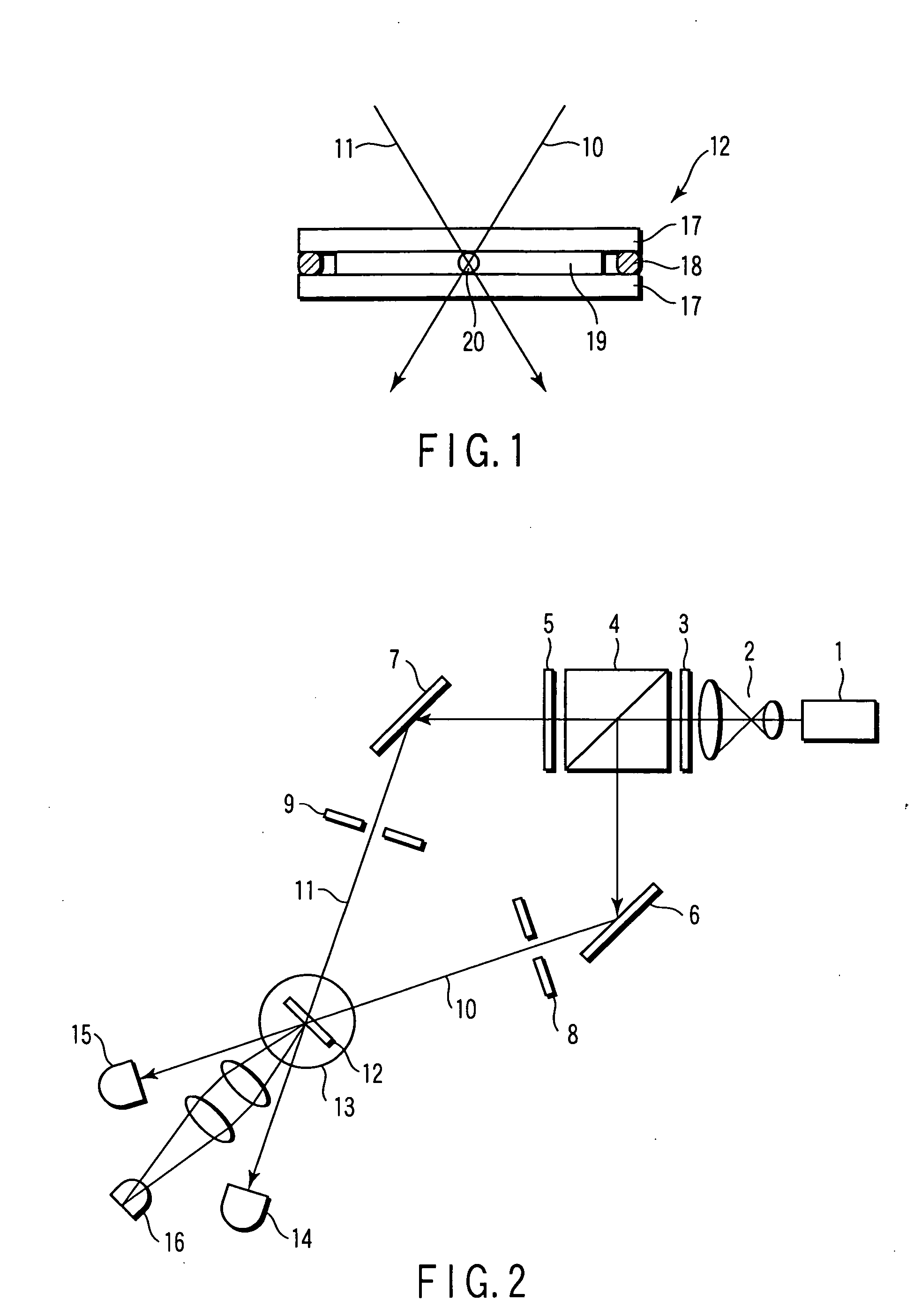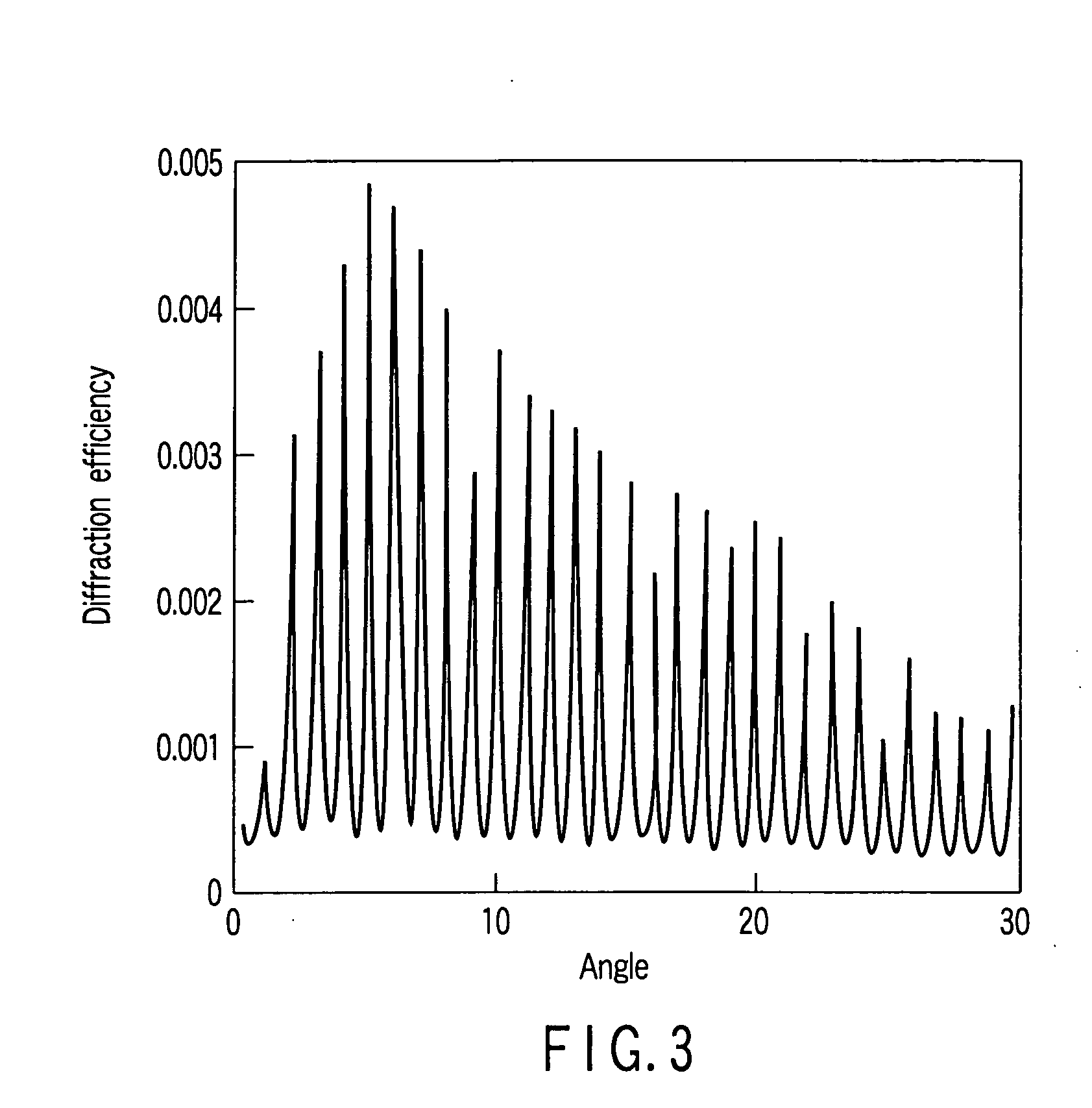Holographic optical recording medium, manufacturing method thereof and holographic optical recording method
a technology of optical recording medium and manufacturing method, which is applied in the field of optical recording medium, can solve the problems of volume expansion of the recording layer, and inability to form a recording layer having a desired thickness
- Summary
- Abstract
- Description
- Claims
- Application Information
AI Technical Summary
Problems solved by technology
Method used
Image
Examples
example 1
A raw material composition for a recording layer was prepared by mixing 16 g of a compound represented by chemical formula (6) given previously, which had an m:n ratio of 7:3 and which was used as a polysilane having a hydroxyl group, 13 g of “CELLOXIDE 2021” (trade name of 3,4-epoxy cyclohexenyl methyl-3′,4′-epoxy cyclohexene carboxylate manufactured by DAICEL CHEMICAL INDUSTRIES,LTD.), which was used as an epoxy compound, and 0.6 g of 2-methyl imidazole used as a curing catalyst, followed by defoaming the mixture.
The raw material composition for the recording layer thus obtained was poured into a clearance between two glass plates arranged to face each other with a spacer made of a Teflon sheet interposed therebetween. Then, the resultant structure was heated at 60° C. for 24 hours under a light-intercepted condition so as to obtain a test piece of a holographic optical recording medium including a recording layer having a thickness of 500 μm.
The test piece thus prepared was ...
example 2
A raw material composition for a recording layer was prepared by mixing 10 g of “PPSi” (trade name of a compound represented by chemical formula (12), manufactured by Osaka Gas Chemical Co., Ltd. and used as a polysilane having a hydroxyl group), 10 g of 1,4-butane diol glycidyl ether used as an epoxy compound, 3 g of diethylene triamine used as a curing agent, 0.7 g of “Irgacure 784” (trade name of a photo radical generating agent manufactured by Ciba Specialty Chemicals), and 0.15 g of t-butyl hydroperoxide (dilution with water: active oxygen 12%, manufactured by NOF CORPORATION), followed by defoaming the resultant mixture.
The raw material composition for the recording layer thus obtained was poured into a clearance between two glass plates arranged to face each other with a spacer made of a Teflon sheet interposed therebetween. Then, the resultant structure was maintained at room temperature for 48 hours under a light-intercepted condition so as to obtain a test piece of a ho...
example 3
A raw material composition for a recording layer was prepared by mixing 10 g of a compound represented by chemical formula (10) in which the m:n ratio was 8:2, which was used as a polysilane having a hydroxyl group, 10 g of propylene glycol diglycidyl ether having an epoxy equivalent of 165 and used as an epoxy compound, 0.15 g of triphenyl phosphine used as a curing catalyst, 0.10 g of Irgacure 819 manufactured by Ciba Specialty Chemicals and used as a photo radical polymerization initiating agent, 1 g of N-vinyl pyrrolidone and 11 g of 2,4,6-tribromophenyl acrylate, followed by defoaming the resultant mixture.
The raw material composition for the recording layer thus obtained was poured into a clearance between two glass plates arranged to face each other with a spacer made of a Teflon sheet interposed therebetween. Then, the resultant structure was heated at 50° C. for 10 hours under a light-intercepted condition so as to obtain a test piece of a holographic optical recording m...
PUM
| Property | Measurement | Unit |
|---|---|---|
| thickness | aaaaa | aaaaa |
| thickness | aaaaa | aaaaa |
| thickness | aaaaa | aaaaa |
Abstract
Description
Claims
Application Information
 Login to View More
Login to View More - R&D
- Intellectual Property
- Life Sciences
- Materials
- Tech Scout
- Unparalleled Data Quality
- Higher Quality Content
- 60% Fewer Hallucinations
Browse by: Latest US Patents, China's latest patents, Technical Efficacy Thesaurus, Application Domain, Technology Topic, Popular Technical Reports.
© 2025 PatSnap. All rights reserved.Legal|Privacy policy|Modern Slavery Act Transparency Statement|Sitemap|About US| Contact US: help@patsnap.com



